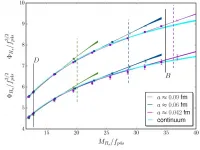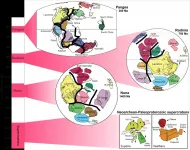(Press-News.org) umans are remarkably adaptable, and our ancestors have survived challenges like the changing climate in the past. Now, research is providing insight into how people who lived over 5,000 years ago managed to adapt.
Madelynn von Baeyer Ph.D. '18, now at the Max Planck Institute for the Science of Human History, UConn Associate Professor of Anthropology Alexia Smith, and Professor Sharon Steadman from The State University of New York College at Cortland recently published a paper in the Journal of Archaeological Science: Reports looking at how people living in what is now Turkey adapted agricultural practices to survive as conditions became more arid.
The work was conducted as von Baeyer's doctoral research at Çadr Höyük, a site located in Turkey that is unique because it has been continuously occupied for thousands of years.
"I was interested in studying how plant use was impacted by changing cultural patterns. This fit Steadman's research goals for Çad?r Höyük really well," says von Baeyer.
Smith explains the site is situated in an area with rich agricultural and pasture land that sustained generations through time.
Professor Sharon Steadman from The State University of New York College at Cortland photographing the dig site. (Contributed photo)
"People would build a mud brick structure, and over the years the structure is either abandoned or collapses and the people just build on top of it," Smith says. "Eventually these villages look like they have been built on hills, but they're really just occupations going up and up."
Just as the occupants built new layers up, the archaeologists excavate down to get a glimpse of history and how lives changed over the millennia. Within the layers, archaeobotanists like von Baeyer and Smith look for ancient plant remains; for instance, intentionally or unintentionally charred plant matter. Though wood was often used, much can be learned by looking at the remains of fires fueled by livestock dung, says Smith: "The dung contains seeds that give clues about what the animals were eating."
Von Baeyer explains the research process: "Archaeobotanical research has three, vastly different, main stages: data collection, identification, and data analysis. Data collection is in the field, on an archaeological dig, getting soil samples and extracting the seeds from the dirt; identification is in the lab, identifying all the plant remains you collected from the field; and data analysis to tell a full story. I love every step."
The focus was on a time period called the Late Chalcolithic, roughly 3700-3200 years before the common era (BCE). By referencing paleo-climatic data and Steadman's very detailed phasing at Çad?r Höyük, the researchers were able to discern how lifestyles changed as the climate rapidly shifted in what is called the 5.2 kya event, an extended period of aridity and drought at the end of the fourth millennium BCE.
With climate change, there are lots of strategies that can be used to adapt says Smith, "They could have intensified, diversified, extensified, or abandoned the region entirely. In this case they extensified the area of land used and diversified the herds of animals they relied upon."
Zooarchaeologists on the site examined the bones to further demonstrate the shift in the types of animals herded, while the seeds from the dung-fueled fires at the dig site gave clues to what the animals were eating.
Smith says, "We know they were herding cattle, sheep, goats, and pigs, and we saw a shift to animals that are grazers. They all have a different diet, and by diversifying you are maximizing the range of potential calories that can eventually be consumed by humans."
By employing this mixed strategy, the people of Çad?r Höyük were ensuring their survival as the climate became increasingly dry. Smith says that at the same time they continued to grow wheat, barley, chickpeas, and lentils, among other crops for humans, while the animals grazed on crops not suitable for human consumption -- a strategy to maximize resources and resilience.
Von Baeyer says she was not expecting to make an argument about climate and the environment at the outset of the study.
"What this study does is pretty rare in archaeobotany by tracing a shift due to climate change over a relatively short time period," she says. "Often when archaeobotanical studies talk about shifts in plant use over time, it's over large cultural changes. This study looks at a shift that only spans 500 years."
Though the circumstances are not exactly the same as they were nearly 6000 years ago, there are lessons we can apply today, says von Baeyer.
"We can take this idea of shifting animal management and feeding practices and make it work in a current context," she says. "I think that this case study, and other studies that use archaeological data to examine climate change, expands the range of possibilities for solutions to shifting environmental conditions. I think archaeological case studies invite more out of the box thinking than just current case studies. Right now, we need to think as creatively as possible to come up with sustainable and efficient responses to climate change."
INFORMATION:
To learn more about the team and work happening at the Çadr Höyük archaeological project, visit cadirhoyuk.org.
March 24, 2021 - With heavy workloads and high professional and personal demands, medical residents in training - and those in urology residency programs - face a high risk of burnout. At one urology department, a wellness program designed by and for residents produced meaningful reductions in burnout risks, reports a study in Urology Practice®, an Official Journal of the American Urological Association (AUA). The journal is published in the Lippincott portfolio by Wolters Kluwer.
The Resident Wellness Curriculum (RWC) in the Scott Department of Urology at Baylor College of Medicine, Houston, led to significant improvements in key aspects of burnout, according to the new research by Jennifer M. Taylor, MD, and colleagues. ...
Researchers at the Perelman School of Medicine at the University of Pennsylvania have produced a detailed molecular atlas of lung development, which is expected to be a fundamental reference in future studies of mammalian biology and of new treatments for diseases, such as COVID-19, that affect the lungs.
The researchers, who published their study in Science, generated a broad atlas of cell types in the developing and adult mouse lung by measuring the expression of genes in thousands of individual mouse lung cells across the lifespan, covering multiple cell types and ...
Bone turnover markers, and specifically bone resorption markers, are commonly used to monitor patients' response to pharmacological treatment and adherence.
In 2011, the Joint Committee on Bone Marker Standards of the International Osteoporosis Foundation (IOF) and the International Federation of Clinical Chemistry and Laboratory Medicine (IFCC) designated Procollagen type I N-propeptide (PINP) and the C-terminal telopeptide of type I collagen (ß-CTX) in blood as reference bone turnover markers for bone formation and bone resorption, respectively, in osteoporosis. ...
Peer deeper into the heart of the atom than any microscope allows and scientists hypothesize that you will find a rich world of particles popping in and out of the vacuum, decaying into other particles, and adding to the weirdness of the visible world. These subatomic particles are governed by the quantum nature of the Universe and find tangible, physical form in experimental results.
Some subatomic particles were first discovered over a century ago with relatively simple experiments. More recently, however, the endeavor to understand these particles has spawned the largest, most ambitious and complex experiments in the world, including ...
An international team of researchers has found that three commonly used antiviral and antimalarial drugs are effective in vitro at preventing replication of SARS-CoV-2, the virus that causes COVID-19. The work also underscores the necessity of testing compounds against multiple cell lines to rule out false negative results.
The team, which included researchers from North Carolina State University and Collaborations Pharmaceuticals, looked at three antiviral drugs that have proven effective against Ebola and the Marburg virus: tilorone, quinacrine and pyronaridine.
"We were looking for compounds that could block the entry of the virus into the cell," says Ana Puhl, senior scientist at Collaborations Pharmaceuticals and ...
Scientists investigating the genetics of chilli pepper species have discovered a whole host of new chilli hybrids that can be grown by crossing domesticated peppers with their wild cousins. This will allow plant breeders to create new varieties that have better disease resistance and could increase productivity.
Despite their huge world-wide culinary appeal, chillies are relatively difficult to cultivate, being prone to disease and sensitive to growing conditions.
There are 35 species of pepper in the Capsicum family, including five domesticated species. The most well-known ...
The process of fabricating materials is complicated, time-consuming and costly. Too much of one material, or too little, can create problems with the product, forcing the design process to begin again. Advancements in the design process are needed to reduce the cost and time it takes to produce materials with targeted properties.
Funded by the National Science Foundation (NSF), researchers at Texas A&M University are using advanced computational and machine-learning techniques to create a framework capable of optimizing the process of developing materials, cutting time and costs.
"Our general focus ...
Curtin University research has uncovered the first solid clues about the very beginning of the supercontinent cycle of Earth, finding it was kick-started two billion years ago.
Detailed in a paper published in Geology, a team of researchers from Curtin's Earth Dynamics Research Group found that plate tectonics operated differently before two billion years ago, and the 600 million years supercontinent cycle likely only started during the second half of Earth's life.
Lead researcher Dr Yebo Liu from Curtin's School of Earth and Planetary Sciences said that the shift in plate tectonics marked a regime change in the Earth System.
"This regime change impacted on the eventual emergence of complex life and even ...
The talented athletes are there. The cheering fans are there. But the media? It's nowhere to be found.
This is the reality of women's sports, which continue to be almost entirely excluded from television news and sports highlights shows, according to a USC/Purdue University study published on March 24th in Communication & Sport.
The survey of men's and women's sports news coverage has been conducted every five years since 1989. In the latest study, researchers found that 95% of total television coverage as well as the ESPN sports highlights show SportsCenter focused on men's sports in 2019. They saw a similar lopsidedness ...
A research group at the RIKEN Center for Computational Science (R-CCS) has found that glycans--sugar molecules--play an important role in the structural changes that take place when the virus which causes COVID-19 invades human cells. Their discovery, which was based on supercomputer-based simulations, could contribute to the molecular design of drugs for the prevention and treatment of COVID-19. The research was published in the Biophysical Journal.
When SARS-CoV-2--the coronavirus that causes COVID-19--invades a human cell, a spike protein on its surface binds to an enzyme called ACE2 on the surface of the cell. The ...


